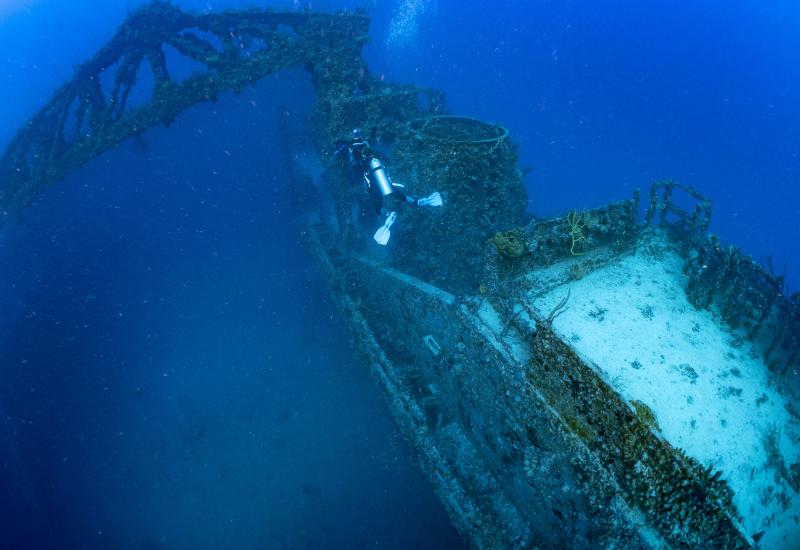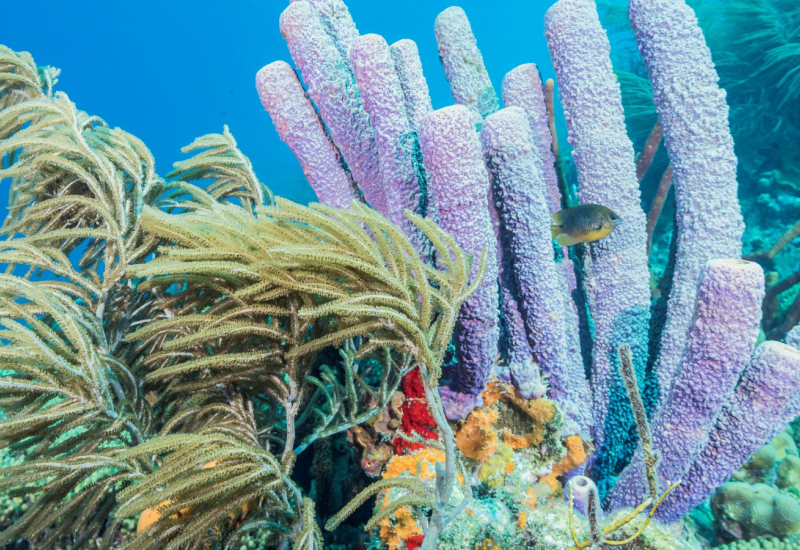Michigan Drive and Dive: The Wrecks of Munising
Pictured Rocks National Lakeshore
Thousands of visitors each year travel miles of Lake Superior shoreline to view colorful weathered sandstone that makes up one of Mother Nature’s greatest beauties. But while the Pictured Rocks National Lakeshore is one of America’s natural wonders, it’s what lies below these magnificent cliffs that excites scuba divers. One of Michigan’s 14 underwater-protected areas, the Alger Underwater Preserve stretches 113 square miles along the shoreline. Conserved within the frigid waters are dozens of shipwrecks offering divers of various skill levels the opportunity to peek into our nation’s maritime past.
The Bermuda
Among the most popular Great Lakes shipwrecks is the 130-foot schooner Bermuda. Sheltered within Murray Bay, just of the shores of the city of Munising, this intact vessel rests upright in about 30 feet of water. Because of its location in the bay, the Bermuda is often accessible to divers even when Michigan’s unpredictable weather cancels dive opportunities farther out into the lake. There is plenty to see on this wreck — because the shallow depths offer a relatively bright experience, most divers make sure they have time to explore. Depending on lake levels, the deck of this beauty rests just about a dozen feet below surface. Compared with some of Munising’s deeper offerings, the Bermuda radiates welcome warmth, which gives me even more time to cruise along its rails. Most of my air was spent at the bow, where a chain dropped of into Superior silt. The wreck also offers hatches, the bow stem, stern rail and rudder; divers have reported seeing paint on the hull despite decades underwater.
The Smith Moore
Another Munising favorite is the Smith Moore. Deeper, darker and colder than the Bermuda, the Smith Moore is just as beautiful although a bit more taxing to tour. A 226-foot wooden-hulled steamer, the Smith Moore sank in an 1889 collision outside the bay.
Dropping just about 90 feet to the stern on a summertime dive here, I felt as though I were swimming through a green fog when I spotted the ship lying upright. I eased forward along the rail to the boiler house, where I could see the steamer’s giant engine. I took my time traveling toward the bow and dropped down into a few cargo holds, which revealed how much sand now surrounds the ship on the outside. Capt. Peter Lindquist of Shipwreck Tours, our charter, explained that preserve managers keep the Smith Moore from being buried by dredging the sand with pumps.
Because of the depth and cold — these dives are most comfortable in a drysuit — I spent only a half-hour on this shipwreck but was still able to see much of the machinery that went down with the vessel. Capstans, pinrails and pumps are among the items still visible, although experts say many items — including the anchor — were removed years ago. (Today Michigan law protects shipwrecks from those looking for souvenirs.)
The Steven M. Selvick dive
A less historic but just as impressive dive is the Steven M. Selvick, afectionately called the Tugboat. Members of the preserve intentionally sank this 71-foot steam-driven tugboat as a dive site. With the help of numerous volunteers and hours of prep work, the Selvick — which was used during construction of the Mackinac Bridge — was sent about 60 feet to the bottom in 1996. Wave action over the years has pushed the Selvick so that it now rests nearly completely on its port side. I was able to peek in the back holding areas and up through the doorways and windows in the pilothouse, and noticed a large coil of rope still at the bow. Because of its relatively small size, the Selvick can get crowded quickly, but it’s definitely a dive worth doing.
The Kiowa
No list of favorite Alger Preserve wrecks would be complete without the Kiowa. Its location several miles east of Munising means the boat ride out and back offers spectacular views of the Pictured Rocks National Lakeshore. And the dive on this 261-foot, ocean-going freighter offers a chance to explore its many broken pieces.
Kiowa foundered in a 1929 storm; today it rests in about 30 feet of water. Years of waves and ice have crushed much of the ship, but there are still interesting artifacts to discover. Visibility during my visit was limited, but my buddy did spot the corked cannon that we were told to look for. This object — which still had cork in the barrel — was used to shoot rope from ship to shore.
Getting to Munising — located on the far side of the mostly rural Upper Peninsula — requires quite a drive for most visitors. But the certainty of excellent diving makes the trip worth it.
Munising Itinerary
Day 1: If weather permits choose a dive site along the Pictured Rocks National Lakeshore. Back on land, head to Foggy’s Steakhouse & Lounge, where diners can grill their own steaks.
Day 2: If you have an afternoon charter, get up early and take a tour of the area’s many lighthouses. Integral to Michigan’s maritime history, lighthouses offer beautiful photographic opportunities. And because you’re in the Upper Peninsula, stop for a pasty — a meat pie usually eaten by hand — at one of the city’s diners.
Day 3: If you haven’t had enough shipwrecks, Glass bottom shipwreck tours (shipwrecktours .com) are a unique Great Lakes experience. On your drive home, take a detour to see Munising Falls — the Upper Peninsula’s area falls are majestic.
Need to Know
When to Go:
The diving season typically runs from mid-May to early October. Keep an eye on the weather: Heavy winds may limit the shipwrecks that can be visited, or even cause the charter to be canceled.
Dive Conditions:
Lake Superior is the coldest of the five Great Lakes, so drysuits are highly recommended.
Surface temperatures in the summer may hit the low 60s, however prepare for bottom temperatures in the 40-degree range on the deeper wrecks. The visibility at Alger Underwater Preserve can range from 25 to 50-plus feet, depending on weather and the time of year.
Operator:
Shipwreck Tours (shipwrecktours.com/diving- charters) provides scuba-diving opportunities, as well as glass-bottom- boat tours for those not interested in getting wet. Air fills are available, but if you want to dive nitrox, you must bring your own.
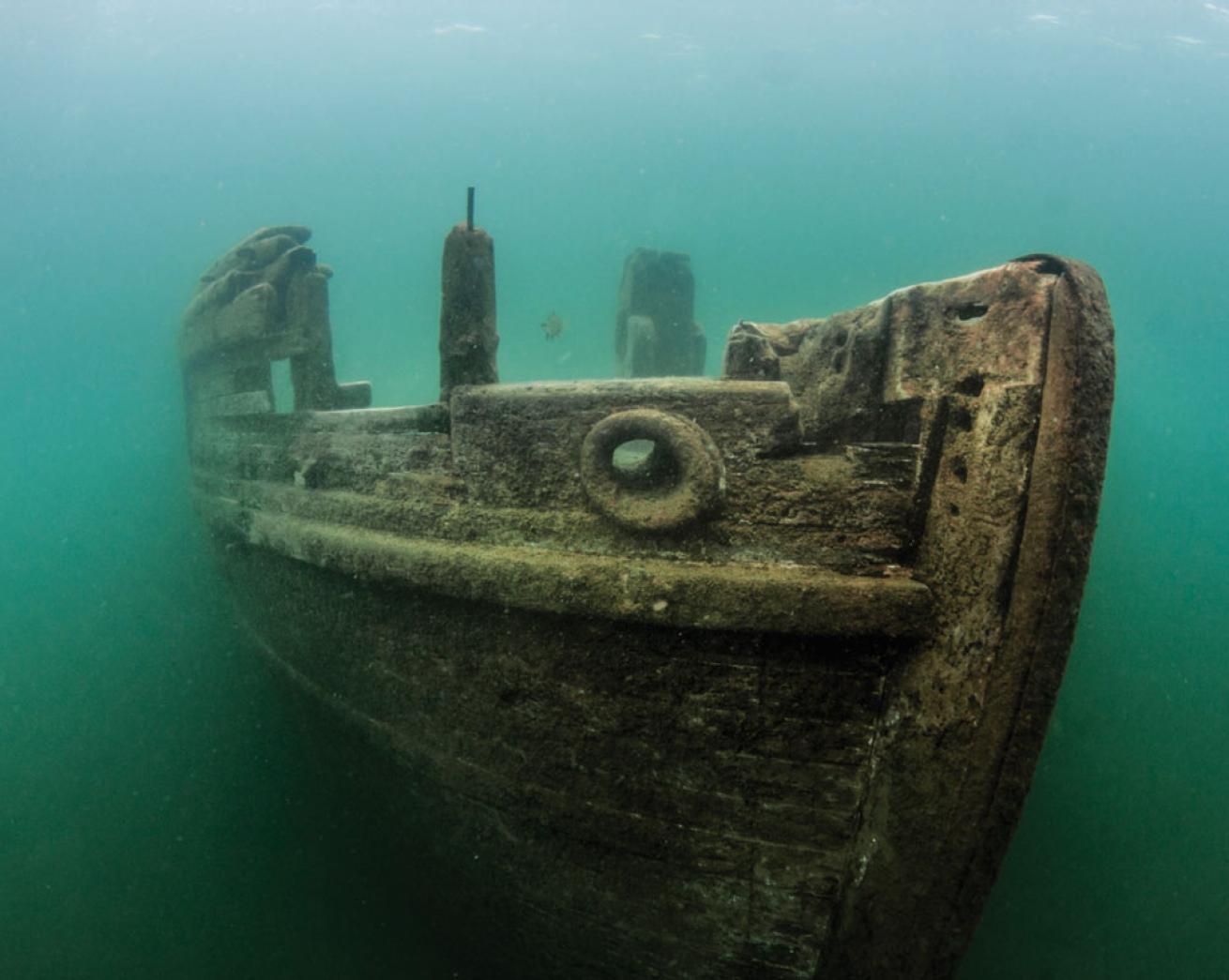
Andy MorrisonDeck of the Bermuda, just 12 feet below the surface.
Pictured Rocks National Lakeshore
Thousands of visitors each year travel miles of Lake Superior shoreline to view colorful weathered sandstone that makes up one of Mother Nature’s greatest beauties. But while the Pictured Rocks National Lakeshore is one of America’s natural wonders, it’s what lies below these magnificent cliffs that excites scuba divers. One of Michigan’s 14 underwater-protected areas, the Alger Underwater Preserve stretches 113 square miles along the shoreline. Conserved within the frigid waters are dozens of shipwrecks offering divers of various skill levels the opportunity to peek into our nation’s maritime past.
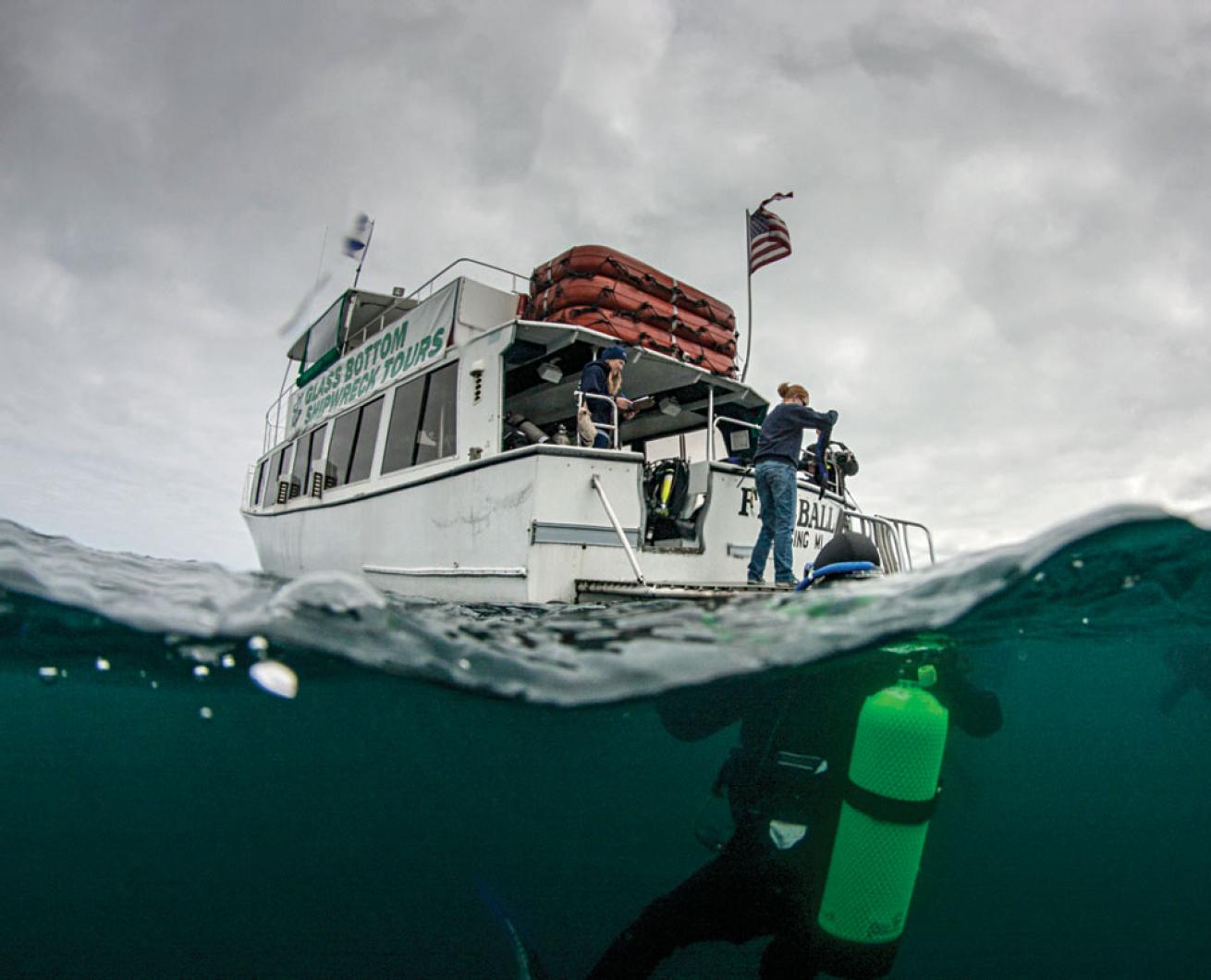
Andy MorrisonA diver drops into the Alger Underwater Preserve.
The Steven M. Selvick
A less historic but just as impressive dive is the Steven M. Selvick, affectionately called the Tugboat. Members of the preserve intentionally sank this 71-foot steam-driven tugboat as a dive site. With the help of numerous volunteers and hours of prep work, the Selvick — which was used during construction of the Mackinac Bridge — was sent about 60 feet to the bottom in 1996. Wave action over the years has pushed the Selvick so that it now rests nearly completely on its port side. I was able to peek in the back holding areas and up through the doorways and windows in the pilothouse, and noticed a large coil of rope still at the bow. Because of its relatively small size, the Selvick can get crowded quickly, but it’s definitely a dive worth doing.
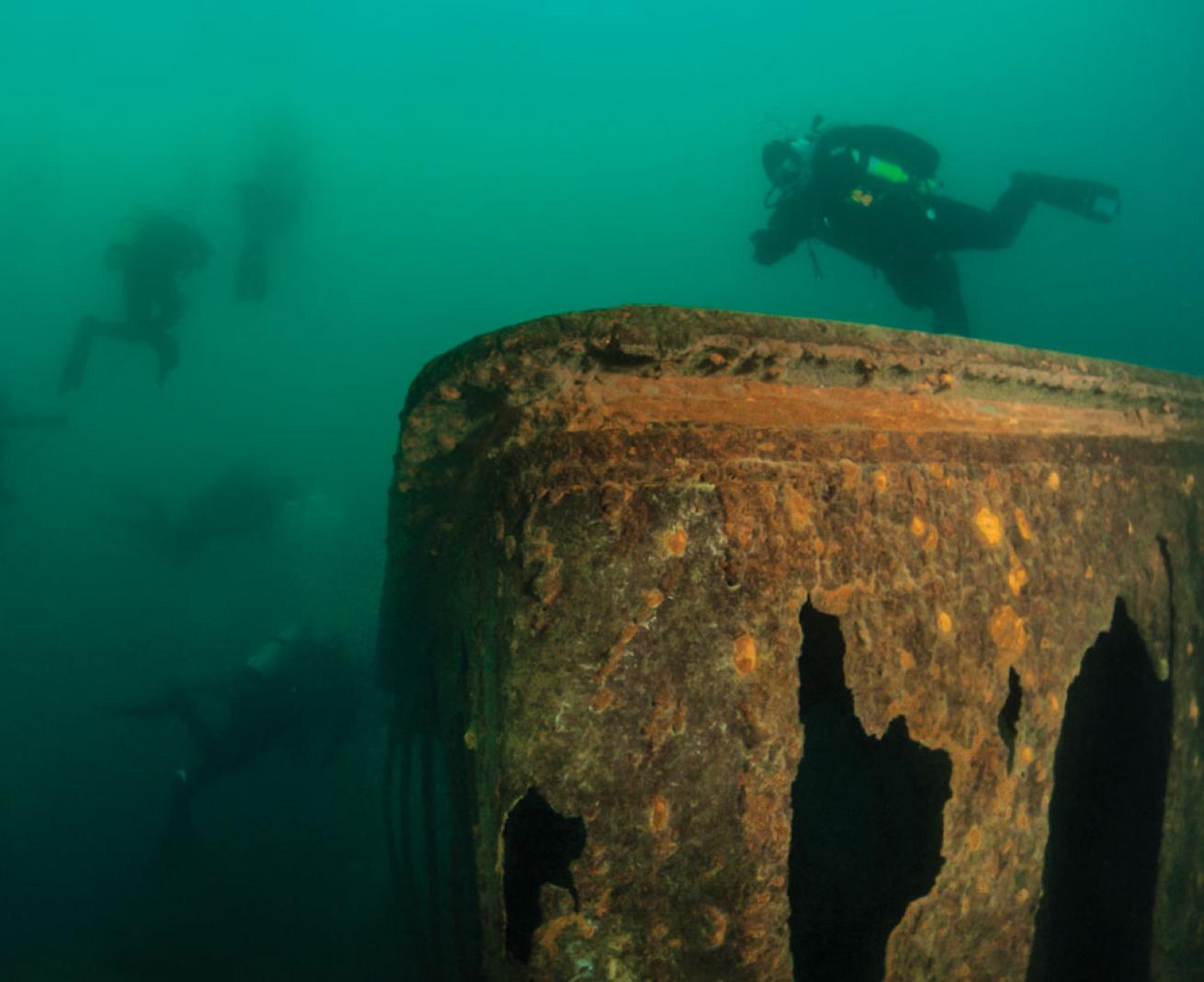
Andy MorrisonDivers on the Smith Moore.
The Bermuda
Among the most popular Great Lakes shipwrecks is the 130-foot schooner Bermuda. Sheltered within Murray Bay, just off the shores of the city of Munising, this intact vessel rests upright in about 30 feet of water. Because of its location in the bay, the Bermuda is often accessible to divers even when Michigan’s unpredictable weather cancels dive opportunities farther out into the lake. There is plenty to see on this wreck — because the shallow depths offer a relatively bright experience, most divers make sure they have time to explore. Depending on lake levels, the deck of this beauty rests just about a dozen feet below surface. Compared with some of Munising’s deeper offerings, the Bermuda radiates welcome warmth, which gives me even more time to cruise along its rails. Most of my air was spent at the bow, where a chain dropped off into Superior silt. The wreck also offers hatches, the bow stem, stern rail and rudder; divers have reported seeing paint on the hull despite decades underwater.
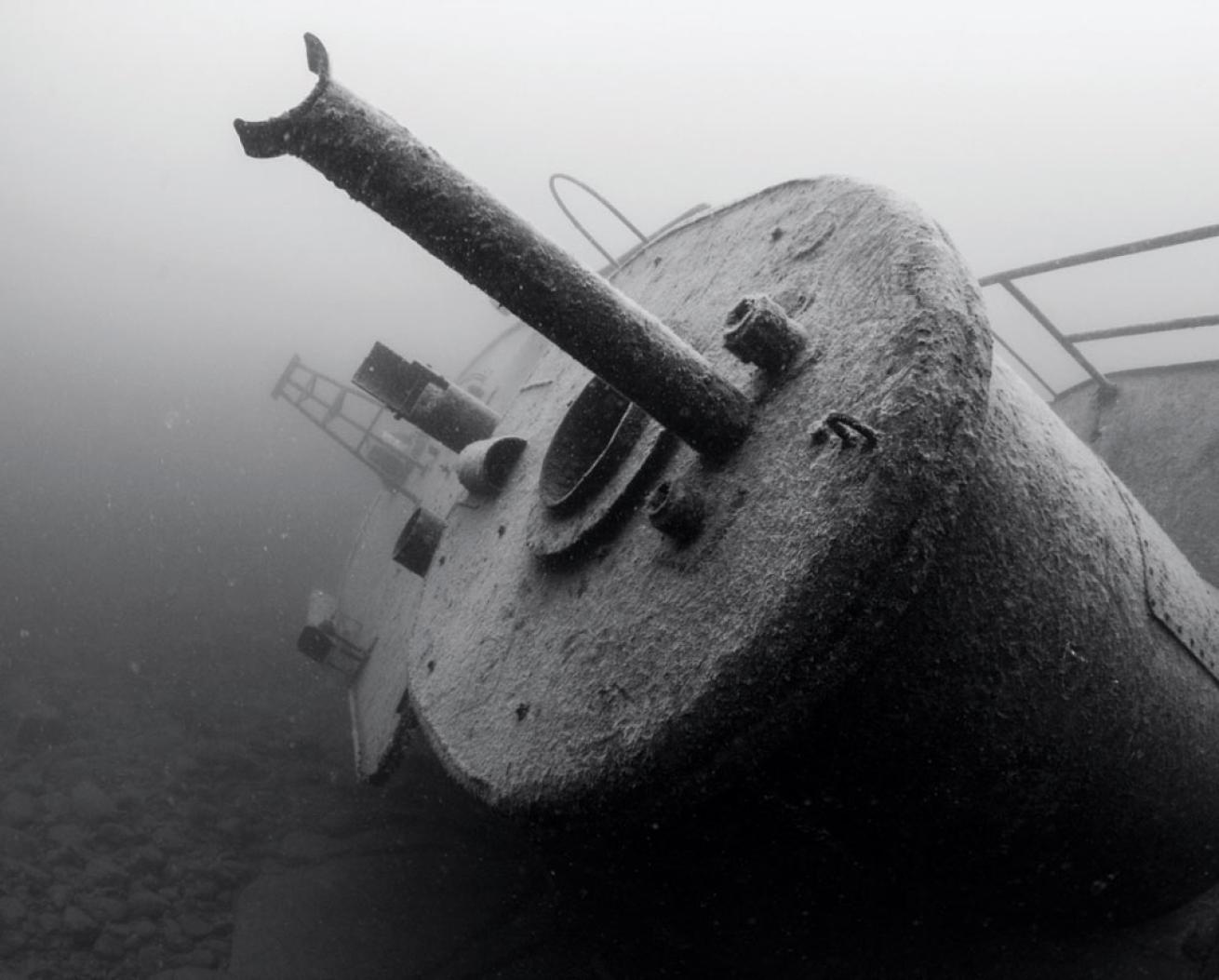
Andy MorrisonSelvick was placed for divers in 1996; it's also known as the Tugboat.
The Smith Moore
Another Munising favorite is the Smith Moore. Deeper, darker and colder than the Bermuda, the Smith Moore is just as beautiful although a bit more taxing to tour. A 226-foot wooden-hulled steamer, the Smith Moore sank in an 1889 collision outside the bay.
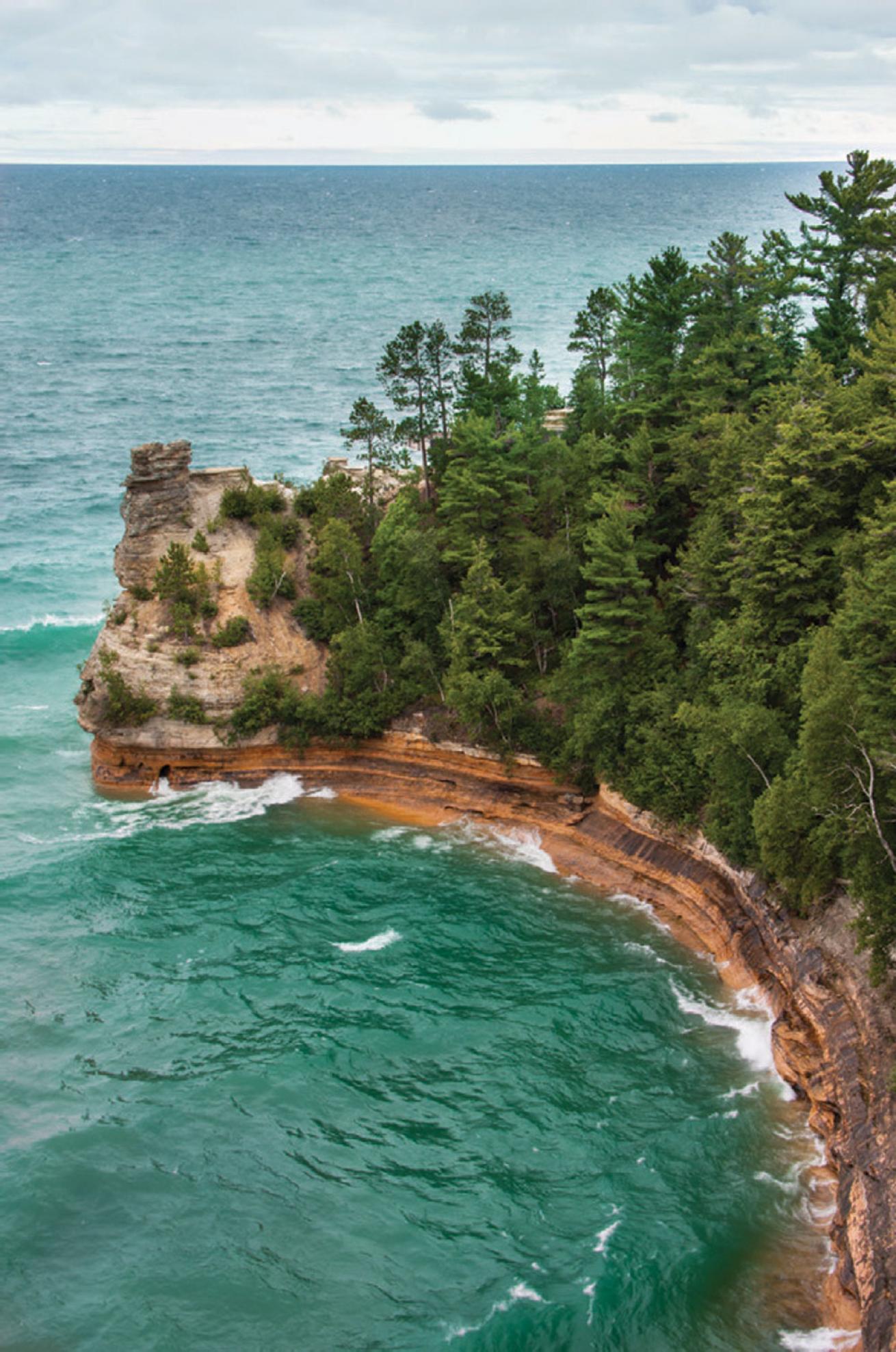
Andy MorrisonMiner's Castle in Michigan.
Dropping just about 90 feet to the stern on a summertime dive here, I felt as though I were swimming through a green fog when I spotted the ship lying upright. I eased forward along the rail to the boiler house, where I could see the steamer’s giant engine. I took my time traveling toward the bow and dropped down into a few cargo holds, which revealed how much sand now surrounds the ship on the outside. Capt. Peter Lindquist of Shipwreck Tours, our charter, explained that preserve managers keep the Smith Moore from being buried by dredging the sand with pumps.
Because of the depth and cold — these dives are most comfortable in a drysuit — I spent only a half-hour on this shipwreck but was still able to see much of the machinery that went down with the vessel. Capstans, pinrails and pumps are among the items still visible, although experts say many items — including the anchor — were removed years ago. (Today Michigan law protects shipwrecks from those looking for souvenirs.)
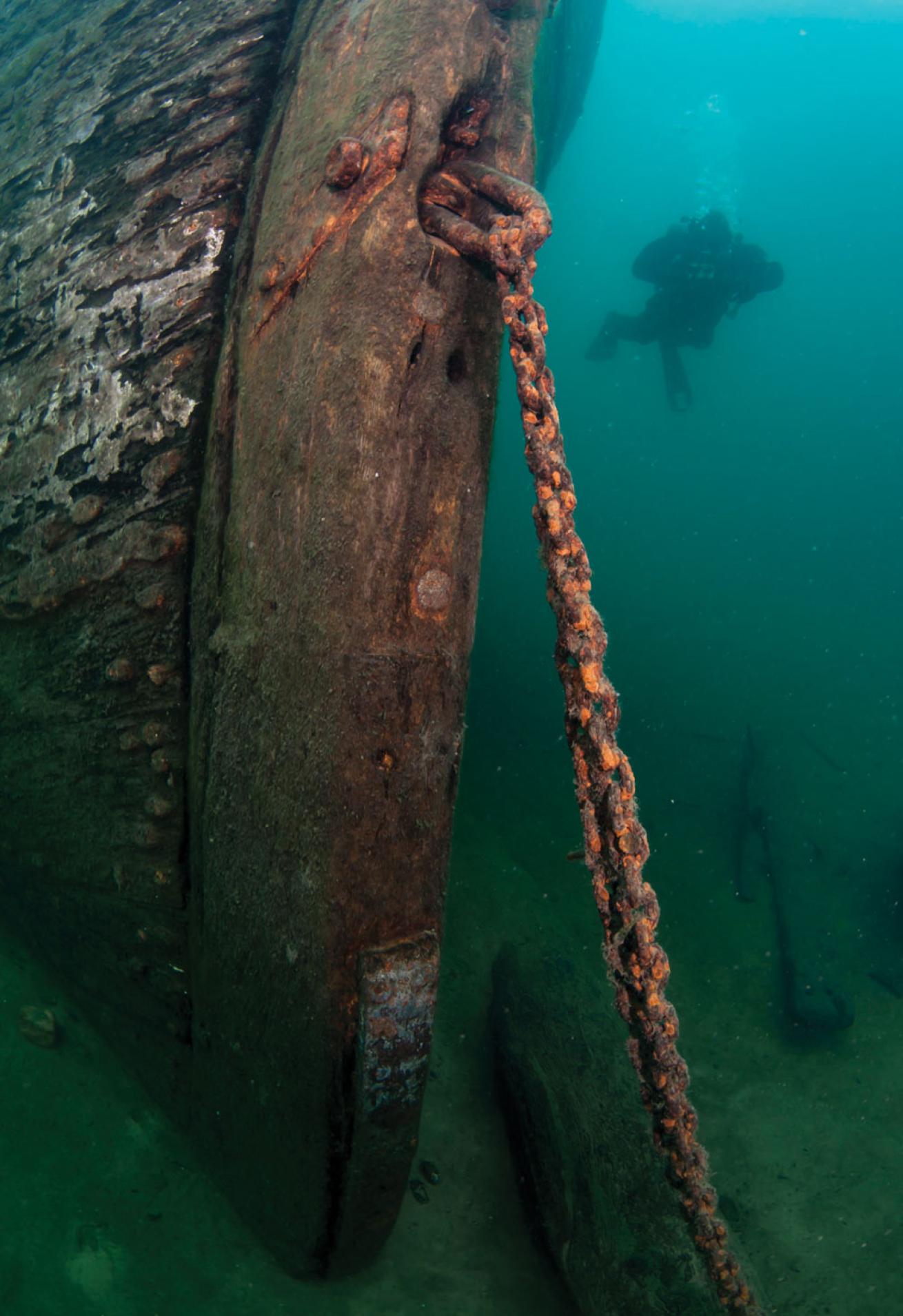
Andy MorrisonA diver approaches the bow of the Bermuda, a wooden schooner that sank off Grand Island on Oct. 15, 1870.
The Kiowa
No list of favorite Alger Preserve wrecks would be complete without the Kiowa. Its location several miles east of Munising means the boat ride out and back offers spectacular views of the Pictured Rocks National Lakeshore. And the dive on this 261-foot, ocean-going freighter offers a chance to explore its many broken pieces.
Kiowa foundered in a 1929 storm; today it rests in about 30 feet of water. Years of waves and ice have crushed much of the ship, but there are still interesting artifacts to discover. Visibility during my visit was limited, but my buddy did spot the corked cannon that we were told to look for. This object — which still had cork in the barrel — was used to shoot rope from ship to shore.
WANT TO READ MORE ABOUT THE WRECKS OF LAKE SUPERIOR? READ ERIN ALTEMUS’S STORY EXPLORING SUPERIOR’S SUNKEN SHIPS IN NORTHERN WILDS
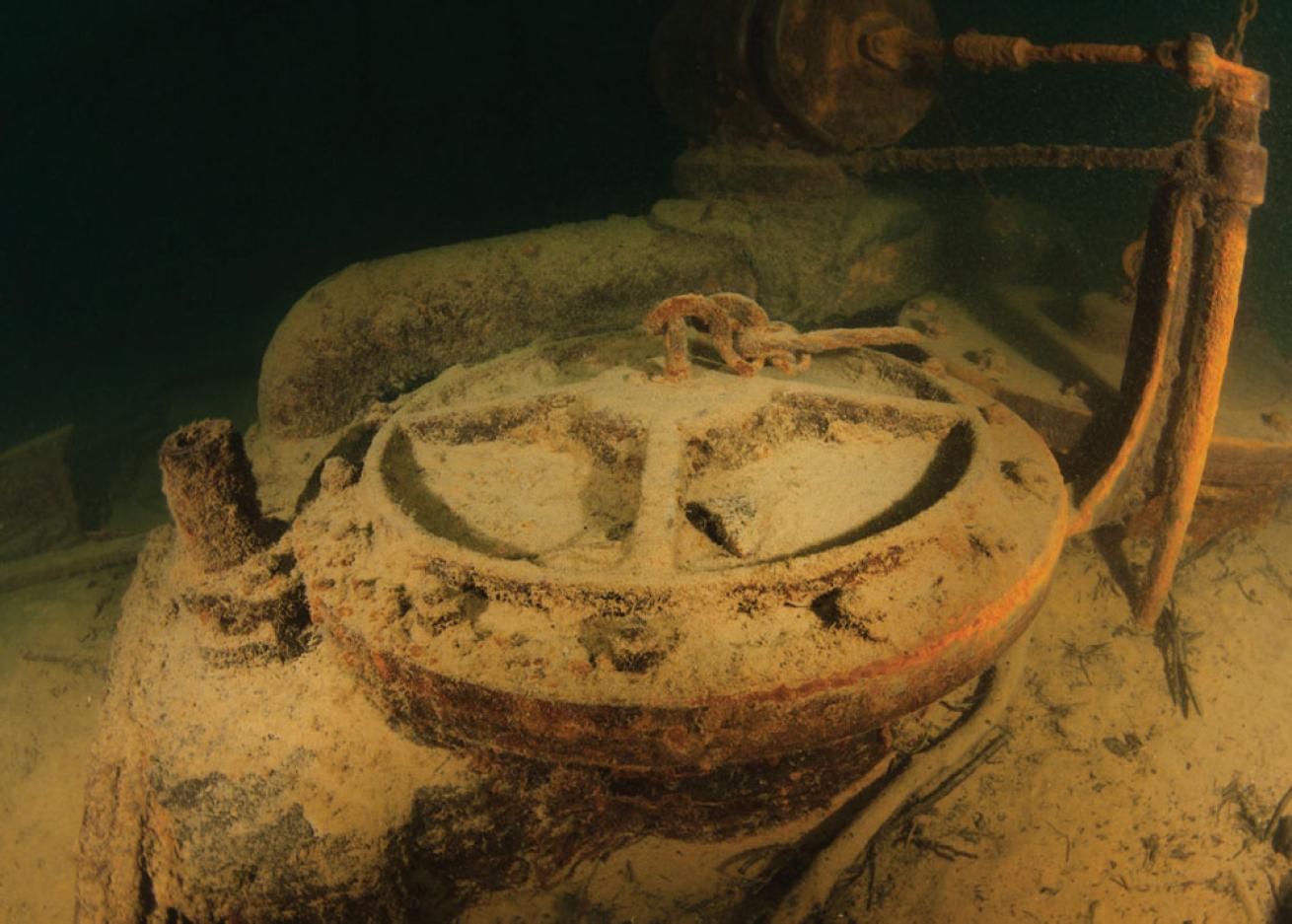
Andy MorrisonEngine of Smith Moore
The 226-foot wooden-hulled Smith Moore sank in an 1889 collision outside the bay. Its engine is shown here.
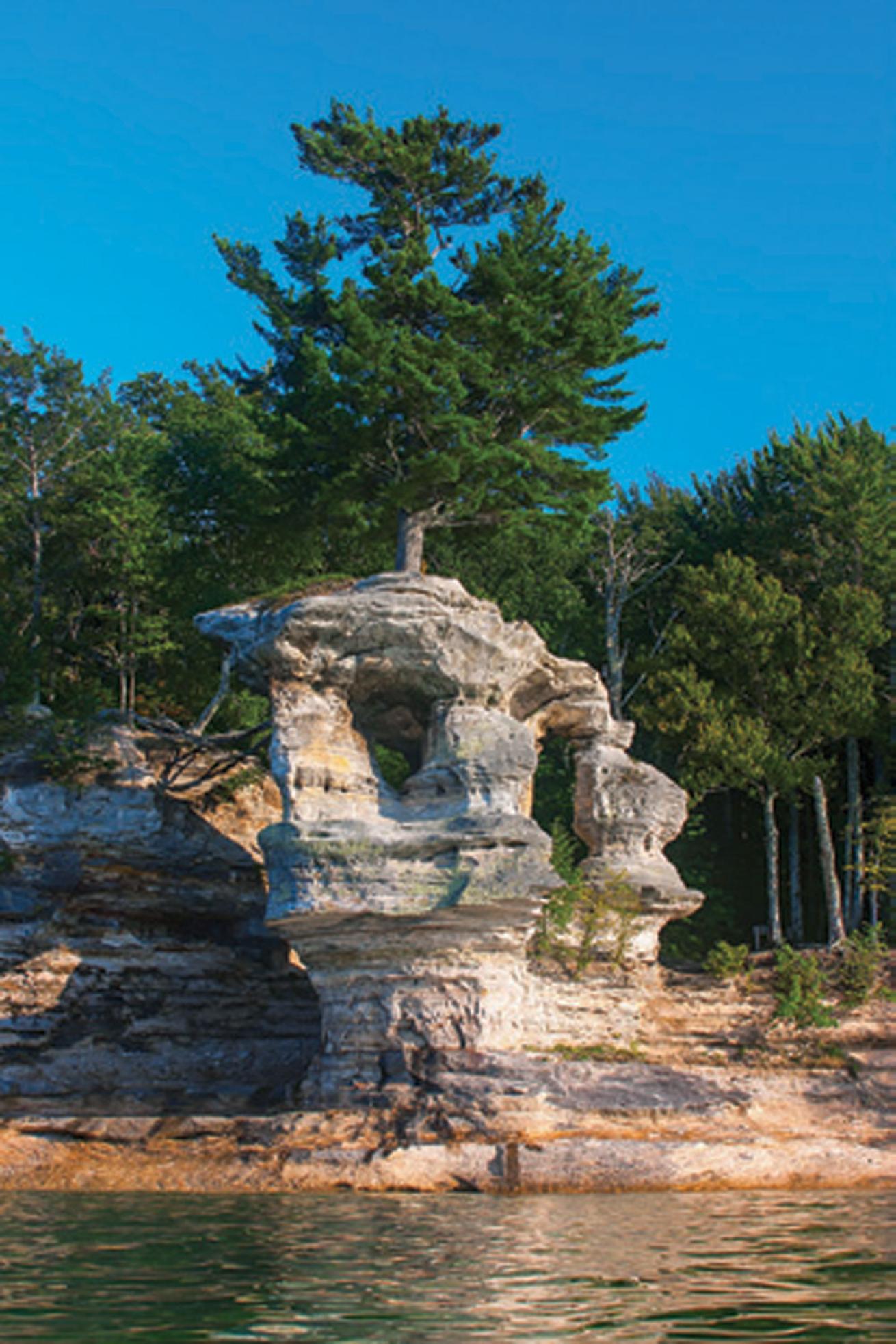
Andy MorrisonThe beautiful, rugged shoreline of Pictured Rocks National Lakeshore.
Munising Itinerary
Getting to Munising — located on the far side of the mostly rural Upper Peninsula — requires quite a drive for most visitors. But the certainty of excellent diving makes the trip worth it.

Andy MorrisonWhen in the Upper Peninsula, stop for a pasty — a meat pie usually eaten by hand — at one of the city’s diners.
Day 1: If weather permits choose a dive site along the Pictured Rocks National Lakeshore. Back on land, head to Foggy’s Steakhouse & Lounge, where diners can grill their own steaks.
Day 2: If you have an afternoon charter, get up early and take a tour of the area’s many lighthouses. Integral to Michigan’s maritime history, lighthouses offer beautiful photographic opportunities. And because you’re in the Upper Peninsula, stop for a pasty at one of the city’s diners.
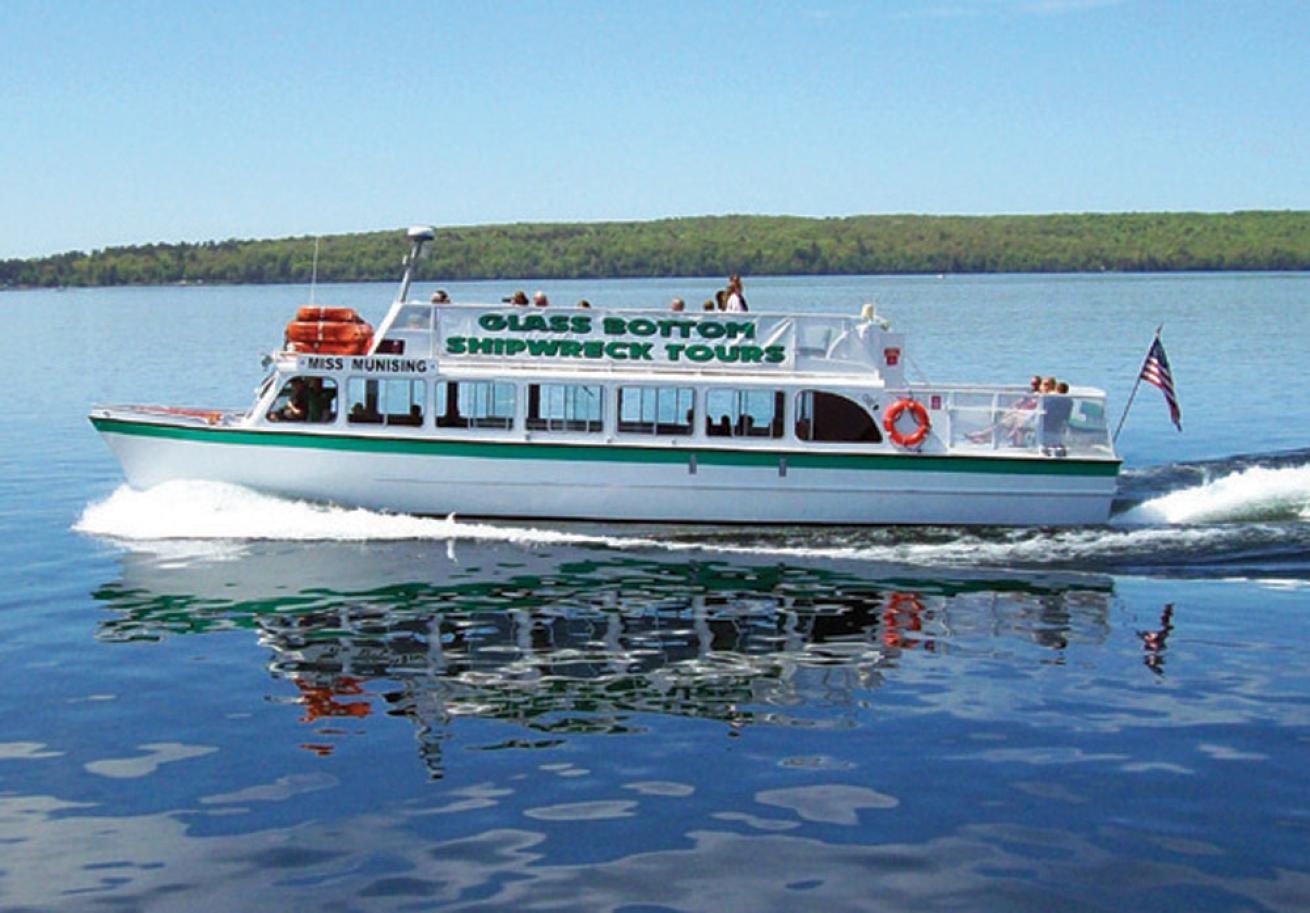
Andy MorrisonGlass-bottom shipwreck tours (shipwrecktours .com) are a unique Great Lakes experience.
Day 3: If you haven’t had enough shipwrecks, glass-bottom shipwreck tours (shipwrecktours .com) are a unique Great Lakes experience. On your drive home, take a detour to see Munising Falls — the Upper Peninsula’s area falls are majestic.
Need to Know
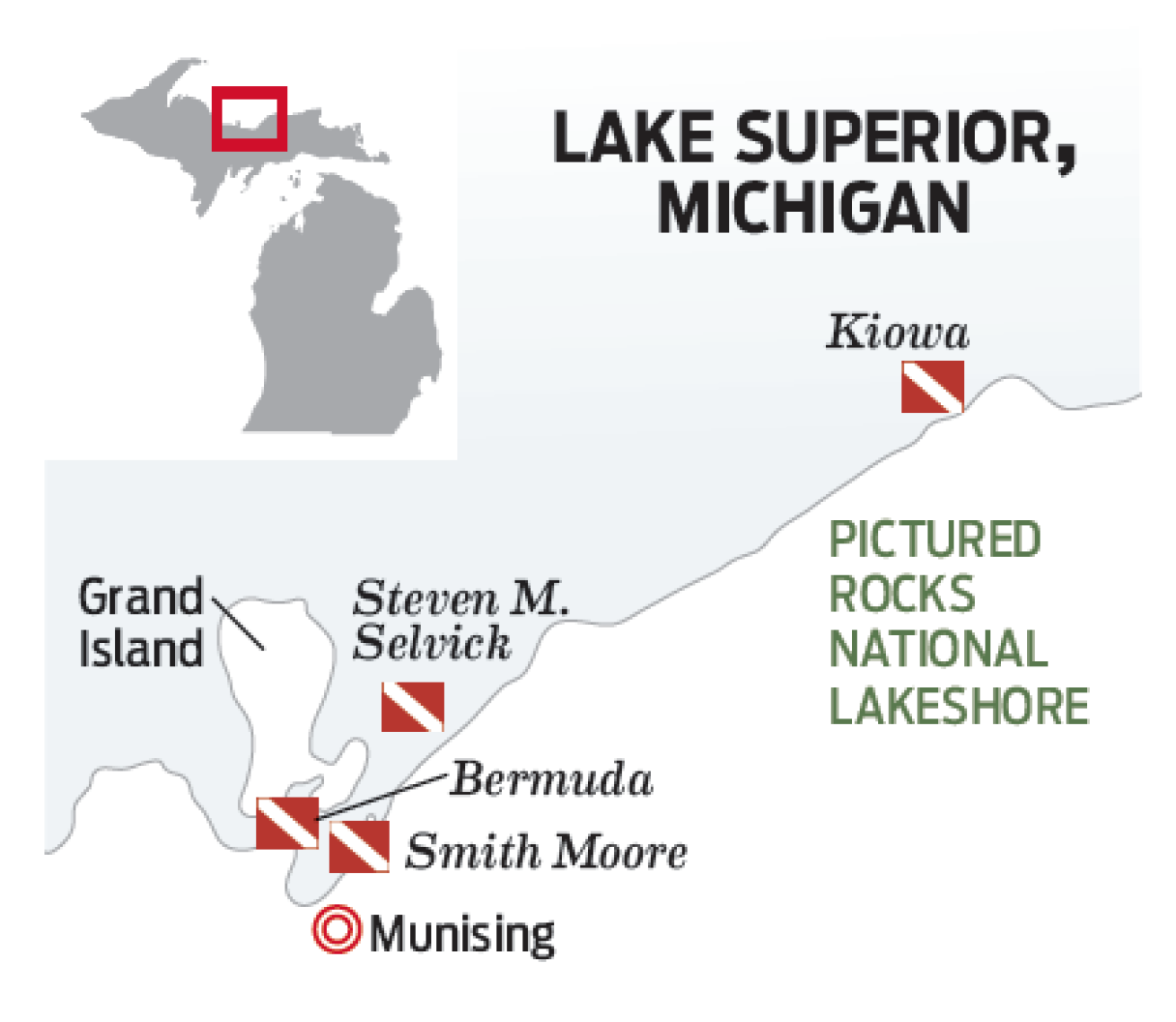
Scuba Diving EditorsAn overview of Pictured Rocks National Seashore.
When to Go
The diving season typically runs from mid-May to early October. Keep an eye on the weather: Heavy winds may limit the shipwrecks that can be visited, or even cause the charter to be canceled.
Dive Conditions
Lake Superior is the coldest of the five Great Lakes, so drysuits are highly recommended.
Surface temperatures in the summer may hit the low 60s; however, prepare for bottom temperatures in the 40-degree range on the deeper wrecks. The visibility at Alger Underwater Preserve can range from 25 to 50-plus feet, depending on weather and the time of year.
Operator
Shipwreck Tours (shipwrecktours.com/diving- charters) provides scuba-diving opportunities, as well as glass-bottom- boat tours for those not interested in getting wet. Air fills are available, but if you want to dive nitrox, you must bring your own.

